|
The Clovis Planetarium Presents: "Seize
the Night"
Observing the Sky in Clovis Over the course of a year, about half the nights in Clovis are clear enough for viewing the sky. Stars and planets appear much brighter and many more can be seen on nights when there is little moonlight. Nights with low humidity and air pollution (such as after cleansing rains and winds, or in the desert) are best, and skies are usually clearest away from the light pollution of the larger urban centers. In California, some of the best viewing is in the mountains, the desert, and other rural locations away from humidity and fog near the coast. The full moon rises at sunset and sets at dawn. It is highest in the sky in December, up to 87 degrees above the horizon in southern California (in summer, it rises only about 30 degrees). Some lunar features show up best when the moon is full-the dark "seas" (hardened lava flows) and the "rays" of bright material splattered from craters. Craters and mountain ranges are best seen before and after full moon, when the angle of sunlight throws them into relief look especially near the terminator, the dividing line between the moon's day and night sides. Because the moon is locked in earth's gravitational grip, the same side of the moon always faces us. PHASES OF THE MOON As the moon makes its monthly orbit around earth. the illuminated lunar surface area appears to grow (wax). shrink (wane), and even disappear (at new moon). The center of the illustration shows the phases, with sunlight coming from the right. The outer drawings show how the moon looks from our perspective on earth. View the Clovis Free Press Moon Phase Calendar.
Cloud-shrouded Venus alternates between being out "morning star" and "evening star," depending on where it is in its orbit. This brilliant planet usually outshines everything in the sky except for the sun and moon. As it circles the sun, Venus displays phases. which can be viewed through a small telescope or high-power binoculars. MARS
Visible in our morning sky for about five months at a stretch and in our evening sky for five months, Jupiter appears brighter than any star in the night sky at all times. The largest planet in our solar system, it has a diameter of 88,850 miles, 11.2 times that of earth. Jupiter's four largest moons: Ganymede, lo, Europa, and Callisto, can often be spotted with binoculars.
Visible most of the year, Saturn appears to the naked eye as a slightly yellowish, moderately bright star. A small telescope reveals its rings, composed mainly of rocky chunks of ice, and the two largest (Titan and Rhea) of its more than 20 known moons. METEORS These "shooting stars" are typically chips ranging from sand-grain to marble size that are knocked off asteroids (tiny planets) or blown off comets and burn up as they strike our atmosphere. The strongest annual meteor showers are the Perseids, which peak around August 12, and the Geminids, which peak around December 13. MAN-MADE SATELLITES During the first hour after dark and during the hour before dawn, even a casual observer is likely to see several man-made satellites crossing the sky-a tiny fraction of the 8,000 or so catalogued objects in orbit. Many of the brightest are about the size of cars or buses. As with our natural moon, satellites are visible due to reflected sunlight. When observing satellites, look for the blinking of tumbling objects, brilliant flashes of sunlight reflecting off solar panels, and sudden fading as they pass into the earth's shadow.
Comets are irregular lumps of ice and rock left over from the formation of the solar system. Occasionally a notable comet approaches the sun as it travels in its far-ranging orbit. The sun's energy vaporizes the comet's surface, generating a tail of gas and dust that may be millions of miles long. Stars and Deep-sky Objects As earth orbits the sun in its annual cycle, our planet's night side faces in steadily changing directions, revealing different stars, constellations, and views of our own Milky Way. People in ancient times named constellations after mythological figures and familiar creatures whose shapes they saw outlined by the stars. The best known of these constellations lie along the ecliptic, the imaginary line that traces the apparent path of the sun through the sky. Earth, our moon, and other planets orbit in nearly the same plane, all traveling along a band roughly 16 degrees wide centered on the ecliptic and called the zodiac. (The zodiac is traditionally divided into 12 segments, but 13 constellations actually intersect it.) Modern constellations are simply designated regions of the celestial sphere, like countries on a map. Most constellations bear little resemblance to their namesakes. Beyond the approximately 6,000 stars visible to the naked eye lie other fascinating deep-sky objects, star clusters, galaxies, nebulas (gas clouds) that can be seen, some with the naked eye and others with binoculars or a small telescope.
Clovis Summer Sky Map Follow this link to star maps for the Summer sky as viewed from the Clovis CA horizon. If you wish to observe at a different time, date or location, note that the same stars appear two hours earlier each month, or one hour earlier every two weeks. The map for the summer season is divided into four quadrants: northeast, northwest, southeast, and southwest. Start by facing the direction in which you have the clearest view; if your best view is southeastward, use the southeast map. The maps plot the constellations and major stars; the wavy, pale blue areas represent the band of the Milky Way; the zenith, the point directly overhead, is indicated. The key to finding your way around the sky is to locate distinctive constellations or star groups (a few are described at right), and then use them to find others. The maps do not chart the planets of our solar system, whose positions change continually. Their locations are often listed in the weather section of newspapers.
On winter nights, we look outward through a spiral arm of our disk-shaped galaxy. Many hot, young blue or white stars (such as Sirius, Rigel, and Procyon), along with some older, cooler yellow and reddish stars (Betelgeuse, Capella, and Aldebaran), dominate the sky. New stars are being born in the Orion Nebula, a mixture of young stars, gases, and dust visible to the naked eye or with binoculars as a fuzzy area in Orion's sword, which hangs from his belt.
The spring sky features the well known Big Dipper, part of the constellation Ursa Major, the Great Bear. The two stars at the end of the Big Dipper's bowl point almost directly at Polaris, the North Star, a moderately bright star (part of the Little Dipper, or Ursa Minor) that lies slightly less than 1 degree from the true north celestial pole. Polaris sits above the horizon at an altitude equal to the observer's latitude (32 to 42 degrees in California).
During the summer months, earth's dark side faces toward the bright center of the Milky Way, making that hazy band of light a dominant feature in the sky. A scan with binoculars through the Milky Way from Cygnus to Sagittarius and Scorpius reveals a dozen or more star clusters and nebulas. High to the northeast, the hot, white stars of the Summer Triangle-Vega, Deneb, and Altair-are usually the first stars visible in the evening. FALL: ANDROMEDA GALAXY
|
©
2000-2003 HTML Graphics by The Clovis Free Press.
All rights reserved.
Return To Clovis Free Press

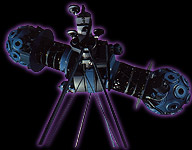 The
sun, the nine planets that revolve around it, and their moons make up
our solar system. Venus, Mars, Jupiter, and Saturn are easily visible
to the naked eye; Even Mercury, Uranus, Neptune, and Pluto can be seen
from the outdoor Clovis Planetarium! Other objects in our solar system
are transient; the wide orbits of comets make them rare visitors near
earth, and meteors flash brightly for only seconds before disappearing.
The
sun, the nine planets that revolve around it, and their moons make up
our solar system. Venus, Mars, Jupiter, and Saturn are easily visible
to the naked eye; Even Mercury, Uranus, Neptune, and Pluto can be seen
from the outdoor Clovis Planetarium! Other objects in our solar system
are transient; the wide orbits of comets make them rare visitors near
earth, and meteors flash brightly for only seconds before disappearing.
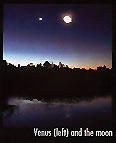 VENUS
VENUS Every
25'/2 months, when earth is aligned between Mars and the sun, Mars is
closest to us and at its brightest and most colorful, appearing orange-red
to the naked eye. At this time, called opposition (opposite in the sky
from the sun), Mars rises at sunset and remains in the sky all night.
Bright, white polar caps and dusky surface markings may be glimpsed
through a small telescope at opposition. Mars rivals Jupiter in brightness
at opposition, but fades somewhat at other times.
Every
25'/2 months, when earth is aligned between Mars and the sun, Mars is
closest to us and at its brightest and most colorful, appearing orange-red
to the naked eye. At this time, called opposition (opposite in the sky
from the sun), Mars rises at sunset and remains in the sky all night.
Bright, white polar caps and dusky surface markings may be glimpsed
through a small telescope at opposition. Mars rivals Jupiter in brightness
at opposition, but fades somewhat at other times. JUPITER
JUPITER SATURN
SATURN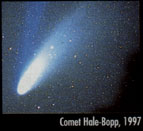 COMETS
COMETS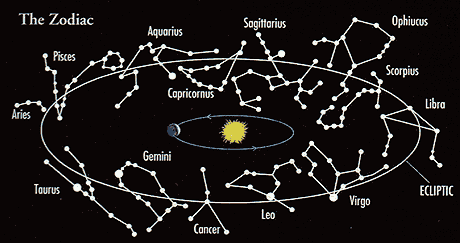
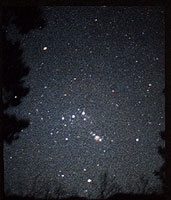 WINTER:
ORION
WINTER:
ORION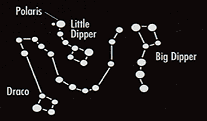 SPRING:
THE DIPPERS
SPRING:
THE DIPPERS SUMMER:
MILKY WAY
SUMMER:
MILKY WAY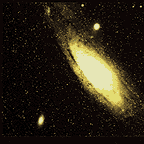 On
autumn evenings, earth's night side faces away from the plane of our
galaxy, allowing us to see other, more distant ones. The Andromeda Galaxy
can be found northeast of the Great Square of Pegasus, just above the
central star on the dimmer northern "leg" of Andromeda. (On the Fall
Sky Southeast map the galaxy is near the first D in Andromeda.) Appearing
as an elongated patch of fuzzy light, it is 2.4 million light years
away.
On
autumn evenings, earth's night side faces away from the plane of our
galaxy, allowing us to see other, more distant ones. The Andromeda Galaxy
can be found northeast of the Great Square of Pegasus, just above the
central star on the dimmer northern "leg" of Andromeda. (On the Fall
Sky Southeast map the galaxy is near the first D in Andromeda.) Appearing
as an elongated patch of fuzzy light, it is 2.4 million light years
away.